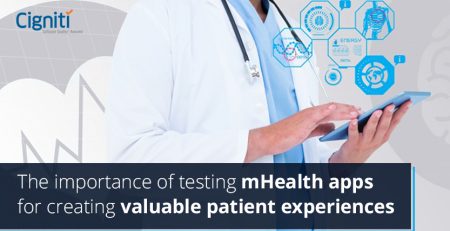Digital Transformation and Innovation in Healthcare: A Critical Need
|
Listen on the go!
|
The pandemic has compelled healthcare delivery organizations (HDOs) to leap a decade into the digital future.
CIOs are constantly pursuing scores of digital solutions. Several of the solutions are disruptive in nature, such as telemedicine or no-touch/no-wait patient flow.
In addition, the cumulative amount of digital change is transformative. Several CIOs around the world have used a digital-first business and IT strategy to achieve similar degrees of transformation.
Patients’ outcomes and experiences will be improved for the better by solidifying digital advances and building on them over the long term.
Digital engagement, digital interactions, and the use of digital products and services are emphasized in a “digital first” strategy, as opposed to today’s in-person-centric model of healthcare delivery.
An in-person visit becomes the exception, occurring only when a digital interaction isn’t adequate.
According to Gartner, “CIOs must propose new or increased business capabilities to help develop, deliver, and capture value as clinical and business operations are redesigned. Technology’s disruptive potential is not recognized by all stakeholders. In terms of change, risks, and benefits, CIOs have a hard time expressing the impact on present clinical and business skills. Company strategies, as well as business and enterprise operating models, are built around capabilities. They give a common vocabulary that allows for meaningful discussions about new methods and models to take place.”
As a CIO spearheading digital transformation and innovation in healthcare and life sciences, you must embrace a digital-first IT architecture to expedite digitalization.
Healthcare professionals all over the world are up against the same problem: how to enhance patient outcomes while keeping costs down.
An ageing population’s demand for chronic disease management is growing, as are technological improvements and empowered patients taking charge of their health.
The construction of a rich health data base, as well as the integration of technologies such as the Internet of Things (IoT), advanced analytics, Machine Learning (ML), and Artificial Intelligence (AI), is considered as a critical component in addressing these difficulties.
It has the potential to improve diagnoses, prophylaxis, and patient therapy, eventually enabling practitioners to make better clinical decisions using an evidence-based approach.
Instead of once every few weeks, real-time interactions allow a physician to observe a patient in real time. Operational intelligence ensures the most efficient use of healthcare resources and services, lowering costs.
Procedure-based payments, antiquated systems, diverse data sources with limited adoption of data standards, technological debt, digital security, and privacy issues, on the other hand, obstruct the effective use of health information to maximize value generation for all healthcare stakeholders.
As a result, the industry is heavily controlled and confined. The ultimate goal is to improve the wellbeing of individuals and save lives by developing an intelligent healthcare provider that is fully equipped to deliver value-based healthcare and a seamless patient experience.
The information technology that supports this purpose must be scalable, secure, dependable, and inexpensive, as well as suited to each organization’s digital maturity level.
The COVID-19 disaster has wreaked havoc on healthcare systems around the world, with the most notable impact being its position as a catalyst for the healthcare industry’s digital transformation.
Just as social distancing measures around the world have begun to soften, businesses are looking towards digital solutions that can help manage the current pandemic and its effects while also averting a recurrence.
How the pandemic expedited the long overdue digital transformation in healthcare
To boost healthcare innovation and combat the coronavirus, companies around the world are adopting proven technological solutions and developing new ones.
Face guards, respiratory pieces, and nasopharyngeal swabs were printed by an AI-based software enterprise that also specializes in medical 3D printing to generate anatomical models.
After clinical studies, they dispatched hundreds of custom-crafted swabs around the United States, Europe, and Asia to collect COVID-19 samples.
Wearable devices frequently do not give reliable enough data to make essential therapeutic decisions.
Healthcare companies have used the Patient Status Engine (PSE) to solve this problem.
By merging wearable sensors with wireless networks and big data, the PSE automates the collection of raw patient data and decision-support tools for clinicians, allowing for high-resolution patient monitoring and the rapid development of high-dependency isolation rooms.
Ultra-wideband (UWB) technology is being used to monitor social separation, and a precise monitoring device is being developed.
By tracking the time of flight of radio signals between devices, UWB technology employs badges and watches to measure how near and for how long individuals come into touch.
It also uses a cloud platform to send out notifications and provide real-time feedback to people who are at risk of contracting the virus.
Thanks to innovative technologies, COVID 19 detection is now possible on a smartphone.
A smartphone camera records light reflected by blood vessels beneath the skin, and an AI-based software employs a light signal processing technique known as (remote photoplethysmography or rPPG).
The app transforms this variance into measures since blood volume in micro-vascular tissue varies in response to respiration, blood pressure, and other factors. It has been claimed that it is as accurate as hospital-grade monitors.
As a result of the pandemic’s extraordinary obstacles, technology solutions that have been in use for some time have been shown to be highly effective, and their use has been expanding ever since.
Videoconferencing, remote monitoring, and data analysis are all valuable contributions to dealing with the current situation, and they are causing a positive shift that will stimulate their adoption in the post-pandemic era.
While the healthcare sector is taking giant leaps towards digital transformation, it is imperative to have digital quality measurement as their next tech goal.
Digital quality measurement in healthcare
What you can’t quantify, you can’t even manage, which is why healthcare digital quality measurement is so critical.
Quality measurement, on the other hand, has become a time-consuming procedure involving humans, paper, several vendors, and a range of electronic health record (EHR) software for many providers.
Healthcare in the United States has been watching as other businesses across the world undergo digital revolutions in areas ranging from customer service to personal finance to grocery ordering.
Some healthcare systems have seen spectacular digital upheavals, as electronic health records (EHRs) have become the norm and imaging technologies have advanced at breakneck speed from film to sharp, diagnostic-quality digital files that can be viewed online from any device.
Today, as more data paradigms in the industry become digital, it’s essential for healthcare quality evaluation to go digital as well, so that real value can be extracted from these genres in terms of better clinical outcomes and lower healthcare costs.
Because of the automated sync of clinical data between providers and payers, which is free of paper, spreadsheets, and proprietary formats, providers will be able to act more swiftly on quality efforts.
A digital quality measurement system that allows payers and providers to communicate with Fast Healthcare Interoperability Resources (FHIR) – standard data would not only foster the uniformity and patient data access that these standards require, but it would also make quality measurement swift.
It will alleviate the months of concern that providers and measurement suppliers have been experiencing while waiting for CMS results. There is no such thing as a human error when it comes to digital measuring because it is error-proof.
The next generation of digital measurement would then enable calculations in real-time, with simple-to-understand dashboards to help determine where quality improvement efforts should be focused, as well as seamless integration with workflow and regulatory reporting that can be completed with the click of a button, all in the name of improving patient outcomes.
The regulations have been established, and the standards have been written. The question is whether you’ll be able to keep up with the transformation by switching to digital measuring once the requirements take effect.
Healthcare will need to be transformed with unmatched solutions and services to deliver continued improvements to the world’s health. These solutions and services are critical for the optimization of digital transformation initiatives while assuring critical service performance for the healthcare industry.
Digital quality solutions for healthcare
When technological advances and breakthroughs emerge, the medical and healthcare industries’ technology capabilities accelerate.
With the introduction of digital healthcare solutions, hospitals, clinics, and other healthcare institutions have been able to significantly improve the provision of medical services and products to their patients.
Digital healthcare software solutions have enabled anything from assisting medical practitioners in recognizing major diseases at an early stage to eliminating medical errors to collaborating on medical cases.
From a commercial standpoint, digital healthcare solutions enable customers to increase their profitability enormously, hence propelling their company forward.
Some of the ways a Digital Healthcare Solution for your business can be orchestrated are as follows:
- Drive development in medical research: Data from a patient, no matter how insignificant it may appear, could be crucial in the future. Medical advancements, some of which are quite recent, are fueled by data gathered from all across the world.
- The benefits of current digital healthcare systems in terms of increasing the research process and output were enumerated in a study on integrating healthcare and clinical research. Medical data obtained through healthcare solutions is better in terms of quality and accuracy, and also eliminates the need for redundant data documentation.
- Patient information can now be easily collected, collated, verified, and used for research and development of new pharmaceuticals and treatments to improve human health and well-being thanks to digital healthcare systems and other technology.
- Hopefully, with all of the patient data obtained from various sources, the medical community will be able to develop effective medicine to combat and eliminate the terrible ailments that plague humanity.
- Information should be centralized for better management, storage, and access: The unification of patient information is one of the most obvious advantages of using digital medical healthcare software. Hospital information, medical advisories, patient medical records, doctors’ directives, and status updates all contain information that is crucial to a patient’s medical treatment and prognosis.
- A digital healthcare system simplifies the process of storing and classifying patient data while reducing errors dramatically. It facilitates and streamlines information access. All medical workers entrusted with caring for a patient, whether doctors, nurses, therapists, or nutritionists, require rapid and dependable access to the patient’s data.
- They can access patient information in real-time via their desktop computer or mobile device thanks to digital healthcare software. Access can be restricted to just those who are actively involved in patient care for increased security.
- Easily share patient data across multiple platforms: Patient information may be shared more quickly with other doctors and healthcare providers thanks to digital healthcare technologies. This is vital in a variety of situations, such as when dealing with important cases that require outside input and expert medical opinions, or when an EMS or ambulance crew needs to present ER personnel with the appropriate information required to receive the patient.
- It is no longer necessary to handle and receive actual patient files in order to share patient information. Users can send and receive files via desktops, laptops, and mobile devices using a digital healthcare system. File transmission is simple and takes only a few clicks, saving users valuable time.
- Enhance patient care continuity: EHR are essential for patient care continuity. Having all of the patient’s information on a single, easily accessible website makes it simple for healthcare providers to stay informed about the patient’s condition.
- Users can access and examine files, scans, prescriptions, diet plans, and notes from other doctors, allowing them to make modifications to the patient’s treatment plan as needed. Direct communication with laboratories, therapists, and other healthcare professionals becomes more fluid and productive, allowing patients to have the greatest medical experience possible.
- Improve health bookings by simplifying the process: Increased patients mean more revenue for your hospital or clinic, which is critical in a growing company. Patients are essential for doctors running a private practice to stay substantial, competitive, and, most importantly, functioning. Patients that come in for appointments account for a significant portion of your revenue.
- You can make the booking procedure more convenient for your patients by using digital healthcare software. Most healthcare systems have customized scheduling capabilities that can be used to construct client-facing scheduling apps.
- You can offer your patients your work calendar, which includes preferred week or month time slots. When someone successfully books an appointment, the availability of your time slots is updated in real-time. This guarantees that your patients choose a time that is convenient for both them and you. This feature helps to reduce no-shows by preventing double bookings.
- Patients’ personalized journeys should be designed and executed: The hardships that typically accompany establishing and executing tailored care plans are considerably reduced thanks to digital healthcare software solutions that make it easy for medical practitioners to consolidate and access a patient’s data.
- According to a study on the systematic delivery of healthcare services, one of the most effective digital healthcare trends in establishing a tailored medical care plan for patients is the use of standardized consultation templates. An independent study on the full adoption of digital technology in healthcare identified a number of advantages, such as the use of AI and robotics to assist patients in treatment and rehabilitation.
- Medications, allergens, health information, and other data are important to help medical providers understand their patients’ needs and design a personalized path that ensures the greatest possible experience and almost predictable results.
- Patients should be motivated to lead a healthy lifestyle: Having to wait for a diagnosis and test results may be a perplexing, annoying, and stressful process for most patients, if not all. The deployment and use of digital technology, particularly AI, in the healthcare industry can help patients achieve better outcomes by not only speeding up their diagnosis but also providing more accurate results.
- The seamless and efficient connection between healthcare professionals/providers and their patients is made possible by digital healthcare software. This capability lets doctors, therapists, and other healthcare professionals collaborate with their patients and provide them with personalized information about their health. You will be able to empower your patients to make the best decisions and plan for a long life that they will embrace the best if you are able to do so.
Understanding the impact of disruptive technologies and developing a business strategy to acquire new capabilities are essential for healthcare providers.
CIOs must propose new or increased business capabilities to help develop, deliver, and capture value as clinical and business operations are redesigned.
Closing thoughts
To achieve digital transformation and crucial business objectives, healthcare and life science disruption necessitate sophisticated IT. CIOs should begin handling the more complex healthcare ecosystem’s future problems and opportunities.
Under 21 CFR Part 11, GxP Compliance, and Good Automated Manufacturing Practices, the healthcare and life sciences industry must follow a variety of norms and regulations (GAMP). Adoption of digital technologies, big data analytics & BI, compliance with a diverse regulatory landscape, legacy modernization, process & system transformation, improving IT efficiencies, and ensuring functional efficiency, performance, security, and privacy of applications, data, and devices are all required.
Cigniti provides software testing services to hospitals, pharmaceutical businesses, healthcare services, clinical labs, diagnostic centers, third-party administrators (TPA), payers, medical equipment manufacturers, healthcare ISVs, and research institutions, among others. With a strong emphasis on regulations, compliance, quality, and more, we provide end-to-end Advisory & Transformation services, Test Automation, and Performance, Functional, & Security Testing solutions.
Cigniti prepares healthcare systems to foray into the digital space with confidence. To understand how we do it, schedule a discussion with our digital transformation and healthcare software testing experts.





Leave a Reply